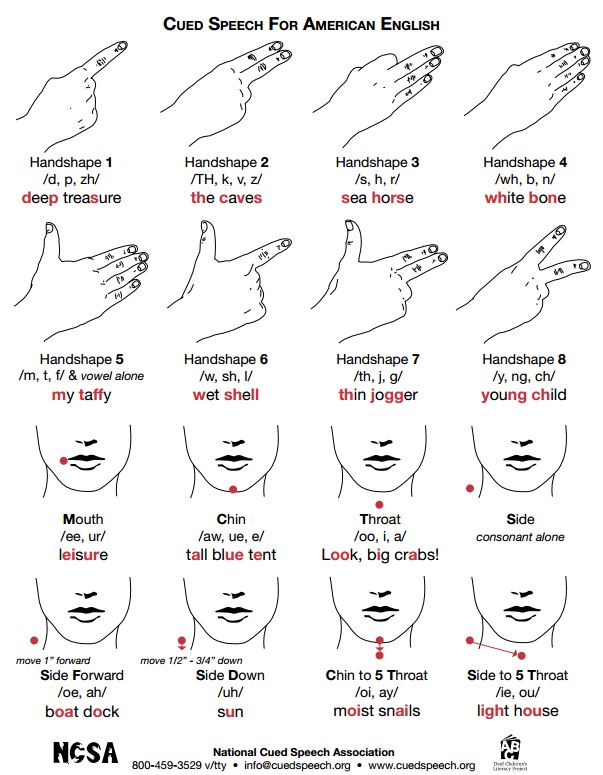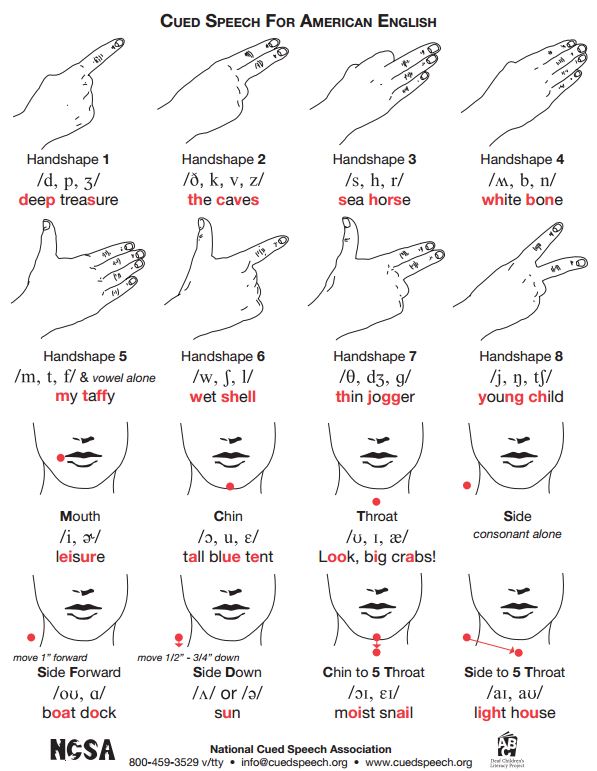Related Products
For Parents
Related Teacher Tools Takeout Items
Cued Speech Information
IDEA (2004) and Cued Speech
“Interpreting services, as used with respect to children who are deaf or hard of hearing, includes oral transliteration services, cued language transliteration services, and sign language interpreting services.” IDEA Sec. 300.34 (b) (4)
The National Cued Speech Association (NCSA) defines Cued Speech as a mode of communication that uses hand shapes to represent consonant phonemes and hand placements to represent vowel phones, building blocks of a language, along with natural mouth movements to remove the ambiguity of lipreading, and to clearly show spoken information through vision alone.
Dr. R. Orin Cornett developed the Cued Speech system in 1965-1966 with the primary goal of improving reading comprehension and to promote literacy for deaf children.
Cued Speech Facts
- Cueing provides access to accents, dialects, rhymes, and fun or nonsense words.
- Using the language of the home, parents are able to communicate naturally with their children while cueing.
- Since American English is the language of instruction in the US, cueing provides access to that language.
- Cued Speech is not a language, but a visual mode to provide access to a spoken language.
- Cued Speech has been adapted to more than 67 languages and major dialects.
- Cueing can be used to make foreign language learning an attainable goal.
- Cueing is not based on spelling. It shows pronunciation and it can be used to correct one’s pronunciation.
- Cueing does not interfere with auditory processing and validates the auditory message.
Applications/ Multiple uses for Cued Speech
- As a mode of communication at home and at school.
- To validate target sounds during speech and language therapy.
- To assist children with special needs (such as children with Autism and Auditory processing disabilities).
- To provide children who are deaf and hard of hearing with a Bilingual education: Cued American English and American Sign Language.
Language Acquisition and Cued Speech
Providing an early and natural language model for deaf children who are born to hearing families is essential to language acquisition. With Cued Speech and through natural communication with those around them deaf children develop phonemic and phonologic awareness of language that is vital to language acquisition. Cued Speech provides access to the building blocks that form the foundation of language and the rules for assembling them. This acquisition of phonology through Cued Speech allows for the natural development of the English language. It also provides an unparalleled foundation upon which literacy and speech production may be learned. If deaf children are exposed to English visually via cueing in everyday interactions, they will develop the phonologic and phonemic awareness to internalize the language in a similar manner to hearing children, (Leybaert, and Charlier, 1996; LaSasso, Crain and Leybaert, 2003.)
Perspectives from a late cuer: https://cuedspeech.org/our-stories/tiffany-matthews/
Cued speech for Professionals http://www.youtube.com/watch?v=B8NjRDmVsmQ
Learning to Cue
Parents, who cue consistently to their deaf children at an early age using the language of the home, provide a visually rich environment. These children learn language the same way hearing children do.
Adults and hearing parents could learn Cued Speech in 15-20 hours. Adults would learn to apply the Cued Speech system to a language they already know. The time it takes to achieve proficiency varies by individual and consistent use.
Cueing classes are offered at Cue Camps (weekend retreats) and workshops throughout the country. Teachers of Cued Speech are certified by the National Cued Speech Association to ensure uniform teaching methods.
Having an instructor is the best way to learn to monitor correct execution of cues and to help avoid building bad habits and incorrect cueing posture. However, other ways to learn Cueing is from a DVD, Skype lessons or materials available at Cued Speech Discovery (www. cuedspeech.com). Cueing charts available at links below:
https://cuedspeech.org/wp-content/uploads/2021/02/Cue-Chart-American-English.pdf
https://cuedspeech.org/wp-content/uploads/2021/02/CS_Charts_Standard-IPA.pdf
Research on Cueing
A small selection of research on cueing shows:
- Children who grew up with consistent exposure to cueing had similar reading comprehension levels to their hearing peers (Wandel, J., 1989)
- Children who cue at home outperform others on rhyme judgment and measured reading achievement (Leybaert, J. & B. Charlier, 1996)
- Young adults from Cued Speech backgrounds demonstrated phonological awareness skills and reading comprehension similar to hearing peers and superior to those from non-Cued Speech backgrounds (LaSasso, C., Crain, K. & Leybaert, J., 2003)
- Cued Speech is effective for Enhancing Speech Perception and First Language Development of Children With Cochlear Implants (Leybaert, J. LaSasso, C., 2010)
Information complied by: Suhad Keblawi, Director of Outreach. skeblawi@cuedspeech.org
National Cued Speech Association (NCSA) www.cuedspeech.org
Information Posted September 30, 2014



